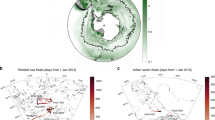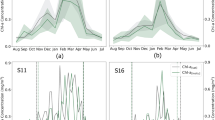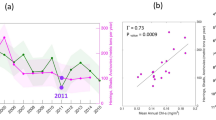Abstract
IT has been argued that the reason for going into space is to obtain a better look at our own planet. One of the specific projects of NASA will be remote measurement of phytoplankton chlorophyll in the world's oceans, the practical use of this measurement most often mentioned relating to pelagic fisheries. A proponent is Dr Maurice Blackburn of Scripps Institution of Oceanography, who argues that the detection of phytoplankton concentrations by the measurement of chlorophyll may increase the efficiency of the tuna fisheries by reducing the scouting time necessary for the fishing fleet. Blackburn's arguments are based on a rather simple hypothesis that the distribution of a pelagic fish such as the tuna is controlled by water temperature and the availability of food1. His group has tested this hypothesis in an area off Baja, California, where large schools of tuna concentrate, feeding primarily on a red crustacean. The crustaceans in turn feed at least partially on the phytoplankton, which are abundant in this area. There is some feeling among fishery biologists that the Baja case may be an exception. Also, if the energy change through the food web is higher than the generally accepted value of 10%, small fluctuations in primary production observed in the open ocean may be too small to explain the yield of a particular fish or its distribution2. As Blackburn points out, tests with pelagic fishes are not easily arranged. The opportunity for testing the hypothesis in the Atlantic Ocean occurred when the research vessel Delaware made an exploratory fishing cruise across the North Atlantic Ocean, roughly between the Azores and the North American coast3.
This is a preview of subscription content, access via your institution
Access options
Subscribe to this journal
Receive 51 print issues and online access
$199.00 per year
only $3.90 per issue
Buy this article
- Purchase on Springer Link
- Instant access to full article PDF
Prices may be subject to local taxes which are calculated during checkout
Similar content being viewed by others
References
Blackburn, M., Fish. Bull., 68, 147 (1969).
Steele, J. H., International Commission for the Northwest Atlantic Fisheries, Spec. Publ., 6, 463 (1965).
Cruise Report 63–4, Exploratory Fishing and Gear Research Base, Gloucester, Mass. (US Dept. of Interior, 1963).
Yentsch, C. S., and Menzel, D. W., Deep-Sea Res., 10, 221 (1963).
Yentsch, C., Herbard, F., Ext. J. Cons. Int. Pour L'Exp. Mer, 22, 184 (1957).
Author information
Authors and Affiliations
Rights and permissions
About this article
Cite this article
YENTSCH, C. Remote Sensing for Productivity in Pelagic Fisheries. Nature 244, 307–308 (1973). https://doi.org/10.1038/244307a0
Received:
Revised:
Issue Date:
DOI: https://doi.org/10.1038/244307a0
Comments
By submitting a comment you agree to abide by our Terms and Community Guidelines. If you find something abusive or that does not comply with our terms or guidelines please flag it as inappropriate.



